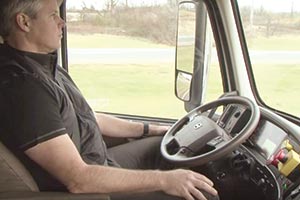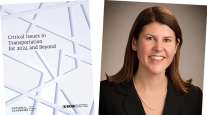Researchers Ponder Effects of Automation on Drivers

This story appears in the Jan. 16 print edition of Transport Topics.
WASHINGTON — Self-driving trucks may be years away from hitting the streets, but industry researchers already are asking how the technology will change the job and career paths for drivers of commercial trucks and buses.
In December, a report issued by the White House Council of Economic Advisors on Artificial Intelligence, Automation and the Economy suggested that more than 80% of the nation’s estimated 1.7 million tractor-trailer drivers and 20% to 60% of 826,510 light truck or delivery service drivers could be replaced by autonomous vehicles in the next two decades.
Such a widespread loss of jobs would cause wages to fall as out-of-work drivers flood the market and necessitate intervention by government or other institutions to provide job training or educational assistance to displaced drivers, according to the report.
At the Transportation Research Board annual meeting here Jan. 9, several members of the Truck- ing Industry Research Committee expressed divergent views on the topic.
Michael Belzer, an associate professor at Wayne State University in Detroit, said the elimination of truck driving jobs would be “socially disruptive” and have “ripple effects” that go well beyond transportation.
“It could turn the entire liberal economic and political environment upside down,” he said. “We need a conversation about the social and political implications of automation on people.”
Besides the loss of jobs, Belzer said, automation could allow drivers with fewer skills to operate vehicles, a process that could further tamp down wages.
Dan Murray, vice president of the American Transportation Research Institute, offered a more optimistic scenario, saying he thinks that automation will help employers fill driving jobs more easily and help drivers to be more productive while in transit.
“It’s not a job that will be de-skilled,” Murray said. “We’ll see a transfer to new skills.”
Others point to the use of technology as a way to make the job of driving more interesting and appealing to young people.
“It can be cool again,” said Zeljko Jeftic, head of global innovation for the International Road Union, a trade association based in Switzerland that represents transport companies mostly in Europe, Asia and the Middle East.
Jeftic said the driver shortage is a global problem: “In Spain, where unemployment among young people is over 50%, we still have a driver shortage. We have to bring in more young people.”
Even with automation, drivers will be essential to protect against hacking, said Don Lefeve, CEO of the Commercial Vehicle Training Association in Alexandria, Virginia.
“Without drivers being able to physically hit a ‘kill’ switch in the event of being hacked, a rogue nation or terrorist could easily weaponize an autonomous truck or a fleet to cause mass casualties,” Lefeve said in response to a request for comment from Transport Topics.
Transportation companies have been investing in automation for a while and, according to a study by PricewaterhouseCoopers, it will continue to disrupt the industry for some time.
“The replacement of labor with capital is a broad trend in the U.S., but in few sectors has it been as evident, or as profitable, as it has been in transportation,” according to the report. “In the last 10 years, almost no sector has increased its capital spending more than transportation, and almost no sector has seen faster growth in revenue per employee.”
Selling airplane tickets or scheduling a freight pickup, for example, no longer requires human interaction and is handled largely through electronic communications devices or the internet.
The PwC report describes three changes that companies must make to remain competitive:
• Establish new automated capabilities to differentiate products and services.
• Develop a facility for strategy and technology planning that combines operational and technical areas of expertise.
• Rethink operational models and make personnel changes needed to manage a more automated business. The importance of general managers, for example, will shrink as engineers and computer scientists overseeing automated equipment play a bigger role.
“Transport companies shouldn’t make the mistake of thinking their future workforces will be smaller but otherwise similar to today’s,” the report warns. “In fact, most transportation companies will need to invest in some very new capabilities if they are gong to have a chance of winning in the future.”




